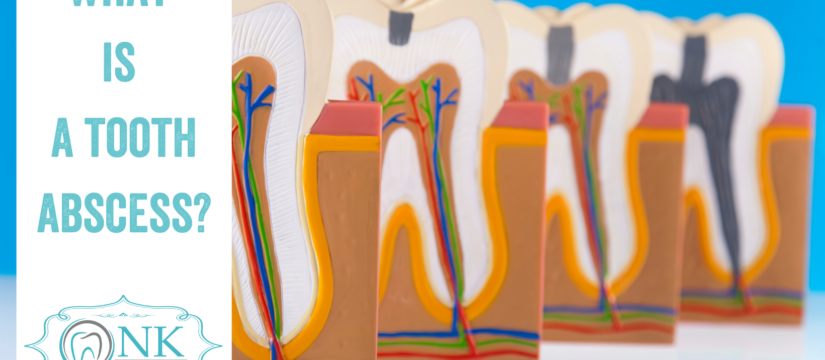
A tooth abscess is a pocket of pus from a bacterial infection. Abscesses can occur in different places around a tooth for different reasons and affect not only the involved tooth, but also the surrounding bone and sometimes adjacent teeth. Cleveland Clinic identifies three types of tooth infections that can cause abscesses:
- Gingival: This infection develops in the gums. It does not usually affect the tooth or supporting structures.
- Periapical: A periapical abscess is an infection that forms at the tip of the root. This occurs because bacteria can spread to the inside of the tooth to the pulp through a fracture or cavity. The pulp is the innermost part of the tooth that contains nerves and blood vessels. When bacteria invades the pulp, they can spread to the tip of the tooth’s root, causing the infection to spread to the bone — eventually leading to an abscess.
- Periodontal: This infection starts in bone and tissues that support the tooth. A periodontal abscess usually results from periodontitis or gum disease and is more common among adults.
What Can Cause an Abscessed Tooth?
Tooth abscesses can have several causes. According to Colgate, the following are the most common:
- A cavity: If you have a cavity, bacteria in your mouth have damaged your tooth, and the decay may have allowed bacteria to reach the blood vessels and nerves in your tooth’s pulp (the inner chamber). According to the World Health Organization (WHO), tooth decay levels are exceptionally high in the United States and the rest of the Americas due to the level of sugars and fermentable carbohydrates consumed here. That’s why the most impactful thing you can do to prevent cavities starts at home. By watching what you eat and practicing good oral hygiene, you can significantly reduce cavity-causing bacteria from flourishing in your mouth.
- A fractured, chipped or broken tooth: If your tooth has been fractured from impact, injury or a problem with an existing root canal, the damage may have allowed bacteria to infect your gums.
- Gum disease: If you have some inflammation or bleeding in your gums, you may be in the early, less severe gum disease stage called gingivitis. If your gingivitis goes untreated, your inflammation can cause tooth abscesses and could even develop into a more severe condition called periodontitis. Periodontitis causes tissue to recede, bone to be destroyed, teeth to loosen, and your teeth could even fall out. Our blog post — “Types of Gum Disease” — covers this condition in greater detail.
What Are The Symptoms of an Abscess?
Considering that tooth pain can have different sources, how can you tell if yours indicates an abscess? Typical symptoms include the following, provided by Mayo Clinic:
- Severe, persistent, throbbing toothache that can radiate to the jawbone, neck or ear.
- Sensitivity to hot and cold temperatures.
- Sensitivity to the pressure of chewing or biting.
- Fever.
- Swelling in your face or cheek.
- Tender, swollen lymph nodes under your jaw or in your neck.
- A sudden rush of foul-smelling and foul-tasting, salty fluid in your mouth and pain relief, if the abscess ruptures.
- Difficulty breathing or swallowing.
Immediately schedule an appointment with your dentist if you experience any of these symptoms. If the abscess ruptures, the pain may decrease significantly — but you still need dental treatment. If the abscess doesn’t drain, the infection may spread to your jaw and to other areas of your head and neck. You could also develop sepsis — a life-threatening infection that spreads throughout the body. Those with a weakened immune system are at even greater risk.
Diagnosing and Treating an Abscess
As mentioned earlier, timely diagnosis and treatment is of the utmost importance when dealing with an abscessed tooth. This is not the time to attempt self-treatment or take a wait-and-see approach.
In addition to examining the tooth and surrounding tissue for signs of infection, your dentist may take the following steps:
- Recommend an X-ray: This can help identify sources of dental disease that may have led to the infection. Your dentist can also use X-rays to determine if the infection has spread and may be affecting other areas.
- Recommend a CT scan: If the infection has spread to other areas within the neck, this will help to identify the extent of the infection.
- Tap and press on your teeth: A tooth with an abscess is often sensitive to touch or pressure.
- Thermal tests: These tests will help your dentist determine the health of your pulpal tissues.
Depending on the type and severity of your abscess, treatment options include:
- Draining the abscess: Your dentist will make a small cut in the abscess to drain the pus. This will be followed by cleaning the area with a saline solution.
- A root canal procedure: A root canal involves drilling into the affected tooth to drain the abscess and remove any infected pulp. Next, your dentist will fill and seal the pulp chamber, which holds pulp, and the root canal. They may also cap your tooth with a crown to strengthen it. A crown procedure is usually performed during a separate appointment. Our blog post — “Signs You Need a Root Canal” — explains this procedure in greater detail.
- Tooth extraction: If your tooth is too damaged, your dentist might remove it before draining the abscess. Your dentist may pull the tooth if it can’t be saved and then drain the abscess.
- Antibiotics: If the infection has spread beyond the abscessed area or you have a weakened immune system, your dentist might prescribe oral antibiotics to help clear the infection.
- Removal of foreign object: If your abscess is caused by a foreign object in your gums, your dentist will remove it. They’ll finish up by cleaning the area with a saline solution.
An Ounce of Prevention
The best way to prevent an abscessed tooth is to practice good oral hygiene. Brush and floss twice a day, and rinse with a fluoride mouthwash — as well as schedule twice-yearly dentist appointments for cleanings and checkups.
The Take-Home Message
An abscessed tooth is a dental emergency that needs to be treated immediately, as the infection won’t go away on its own. If the abscess ruptures, the pain may decrease significantly, but you still need dental treatment. Left untreated, the infection may spread to your jaw and to other areas of your head and neck. You might even develop sepsis — a life-threatening infection that spreads throughout your body. Those with a weakened immune system are at even greater risk.
Depending upon the cause of the abscess, several treatment options are available. Your dentist will be able to determine the best course of treatment. Keep in mind that good oral health is necessary for good overall health. Making oral hygiene and twice-yearly dental checkups part of your regular routine will go far in preventing abscessed teeth and other oral diseases.
We understand that the main concern you may have is cost, which is why we accept all major PPO plans for dental insurance and also offer our in-house dental plan. Please see our financing page for more information.
At NK Family Dental, it is our mission to provide the highest quality and most compassionate oral care to our Chicago patients, including both dental and periodontal services. Our dental specialists include our general dentist, Dr. Nilofer Khan, our endodontist, Dr. Sabek and our periodontist, Dr. Amir Danesh.
Dr. Danesh is a board-certified periodontist and Diplomate of the American Board of Periodontology. He has contributed to the publication of two books, as well as published over 20 papers in prestigious dental research journals.
We serve the neighborhoods of Logan Square, Bucktown, Humboldt Park, and Wicker Park with the dedication that’s earned us the reputation as the Best Dentist in Chicago!
Schedule your visit through ZocDoc, or contact us directly. We look forward to treating you soon!
